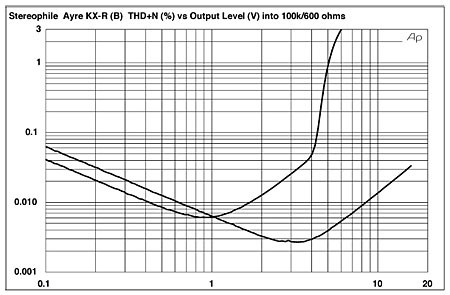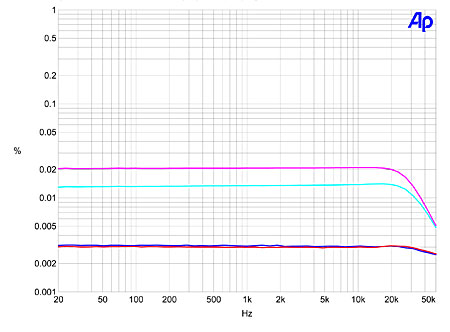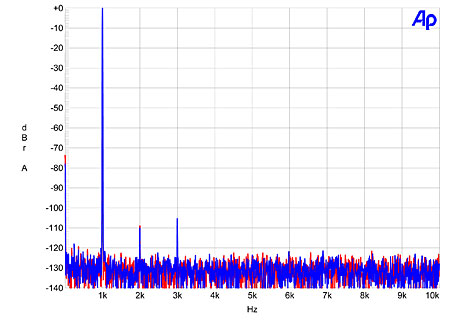| Columns Retired Columns & Blogs |
I've owned the KX-R for two years now and still thinks it's the closest thing to live I've heard .
I mainly used Stereophile's loaner sample of the top-of-the-line Audio Precision SYS2722 system (see the January 2008 "As We See It" and www.ap.com) to examine the Ayre KX-R preamplifier's measured performance.
The top setting of the volume control was an indicated "60" on the display, meaning that there are 61 steps. However, the preamplifier muted when the volume control was set to "60," "59" being the highest practicable setting (footnote 1). The KX-R offered just 0.53dB of gain for both balanced and unbalanced sources in this condition. Using the Setup menu to adjust the chosen input's settings, I applied a +6dB offset; this kept the maximum gain at 0.53dB, but this now occurred at a volume setting of "53." (Again, the maximum setting, which was now an indicated "54," muted the preamp's output.)
As specified, the KX-R offered a very high input impedance. The margin of error in measuring impedances greater than 100k ohms or so is large; all I can say is that the balanced input impedance appeared to be above 1M ohm at all frequencies, with the unbalanced input impedance around 1M ohm. The Ayre's balanced output impedance was also to specification, at 312 ohms balanced across the audioband. Both balanced and unbalanced inputs preserved absolute polarity; ie, were non-inverting. (The XLR jacks are wired with pin 2 hot.)
Ayre specifies the KX-R as having a very wide bandwidth: DC–250kHz! Fig.1 shows the balanced response at 1V into 100k ohms with the volume control set to "59." The output is just –0.2dB at 200kHz, the upper limit of my measurement system. This doesn't change with either volume-control setting or load impedance, and was identical for both the balanced and unbalanced inputs. Channel separation (not shown) was superb, at 120dB in both directions at 1kHz, and was still better than 116dB above 20kHz.

Fig.1 Ayre KX-R, balanced frequency response at 1V into 100k ohms with volume control set to maximum gain (left channel blue, right red). (0.25dB/vertical div.)
I assess a preamplifier's signal/noise ratio by looking at the worst-case scenario: the input is short-circuited but the volume control is set to its maximum, which applies the maximum amplification to the preamp's input-stage noise. Charlie Hansen is correct that reducing the output level with a conventional volume potentiometer will increase the source impedance ahead of a preamplifier's output stage, which does affect the preamplifier's bandwidth, which is why I measure preamplifier frequency response at varying volume control settings. He is also correct that, as the primary noise source in a conventional preamplifier is the active circuitry after the volume control, the noise level tends to remain constant as the volume is reduced. For example, Ayre's K-5xe, which uses a conventional volume control, has a S/N ratio (audioband, unweighted, ref. 1V output, with the volume control at its maximum) of 94.4dB, which is very good. However, as the output level is reduced with the volume control, that noise becomes a larger percentage of the signal. With the preamplifier attenuating the input by 20dB, the effective S/N ratio now becomes 74.4dB.
By contrast, the advantage of the circuit topology used by Ayre for the KX-R is that when the signal level is reduced with the volume control, the noise level will also be reduced. The S/N ratio, expressed in terms of the signal level, will therefore remain constant. Alternatively, when referred to a constant output level, as is my standard practice, the S/N ratio will increase. For example, the wideband, unweighted S/N ratio (ref. 1V output) with the volume control set to "59" was 77.4dB, which increased to 90.7dB when the measurement bandwidth was reduced to the audioband, and to 93.2dB when A-weighted. Reducing the volume by 6dB increased these ratios by 6dB; reducing the volume control by 10dB increased the ratios by the same 10dB. This suggests that at normal volume control settings—Wes Phillips typically listened with the KX-R set to 10–15dB of attenuation, he told me—the preamplifier will indeed be deathly quiet (footnote 2).
The Audio Precision signal generator has a maximum level of 15V, which means that with the small amount of maximum gain offered by the KX-R, I couldn't drive it into actual clipping into 100k ohms (fig.2, bottom trace above 1V). It is pumping out well over 10V with low distortion! Into the punishingly low 600 ohm load (fig.2, top trace above 1V), the Ayre preamplifier clipped (defined as 1% THD) at 5V, which is still well above the level required to drive any real-world power amplifier to its limit. More important, the downward slope of the traces in this graph below 1V (600 ohms) and 3V (100k ohms) means that, below those levels, the measurement is dominated by noise rather than distortion. The actual distortion starts to rise out of the noise around the maximum voltage the preamplifier will be asked to deliver in practical use, meaning that its gain architecture has been sensibly arranged. At 2V into 100k ohms, plotting the THD+noise percentage against frequency really shows only noise (fig.3, blue and red traces). While dropping the load impedance to 600 ohms brings up the distortion by a factor of about 10 (fig.3), with the left channel (cyan trace) a little better behaved than the right (magenta), the level doesn't change with frequency. (The apparent rolloff in THD above 20kHz in this graph is due to the fact that I had the analyzer bandwidth set to 80kHz, meaning that the harmonics of tones with a frequency higher than 20kHz will increasingly be suppressed.)

Fig.2 Ayre KX-R, distortion (%)vs 1kHz balanced output level into (from bottom to top above 1V): 100k, 600 ohms.

Fig.3 Ayre KX-R, balanced THD+N (%)vs frequency at 2V into 600 ohms (left channel cyan, right magenta) and 100k ohms (left channel blue, right red).
The KX-R's linearity performance is shown in a different manner in figs. 4 and 5, the spectra of a 1kHz tone at 2V into 100k ohms and 600 ohms, respectively. The only harmonics visible above the noise floor into the higher impedance are the second, at –110dB (0.0003%), and the third, at –106dB (0.0005%). Not only are these harmonics extremely low in level, they are subjectively innocuous in character. Both harmonics rise into the punishing 600 ohm load: to –83dB (0.007%) and –80dB (0.01%), left; and to –74dB (0.02%), right. But this is still not to a level that approaches audibility. Commendably, no higher harmonics appear into 600 ohms, nor do any power-supply–related spuriae. Intermodulation distortion is also extremely low (fig.6).

Fig.4 Ayre KX-R, spectrum of 1kHz sinewave, DC–10kHz, at 2V balanced into 100k ohms (linear frequency scale; left channel blue, right red).

Fig.5 Ayre KX-R, spectrum of 1kHz sinewave, DC–10kHz, at 2V balanced into 600 ohms (linear frequency scale; left channel blue, right red).

Fig.6 Ayre KX-R, HF intermodulation spectrum, DC–24kHz, 19+20kHz at 2V peak balanced into 100k ohms (linear frequency scale).
The matter of its volume-control idiosyncrasy aside, the KX-R is a superbly well-engineered preamplifier. While it didn't drive the 600 ohm impedance with as much aplomb as it did higher impedances, it will not see this low an impedance in real-life systems, especially as Ayre's own MX-R monoblock, with which the preamp will most likely be used, has an input impedance of 2M ohms. The low maximum gain is something I welcome, as preamplifiers in general are used to attenuate the levels of source signals, not amplify them, and the extremely low level of noise at typical volume control settings is commendable.—John Atkinson
Footnote 2: The Mark Levinson No.380S, which has been my reference preamp for the past 10 years, has a very different volume control, in that level is controlled by feeding the audio signal to the voltage-reference input of a DAC chip. The value of the DAC's internal resistor ladder is then set by applying an 8-bit word to the data input. The kind of control also gives an improvement in S/N ratio as the volume setting decreases, but not to anything like the extent shown by the Aye KX-R. The unweighted, audioband S/N ratio with the No.380S's control set to its maximum was 97dB ref. 1V output. At the very lowest settings of the control, this improved by 9dB.—John Atkinson